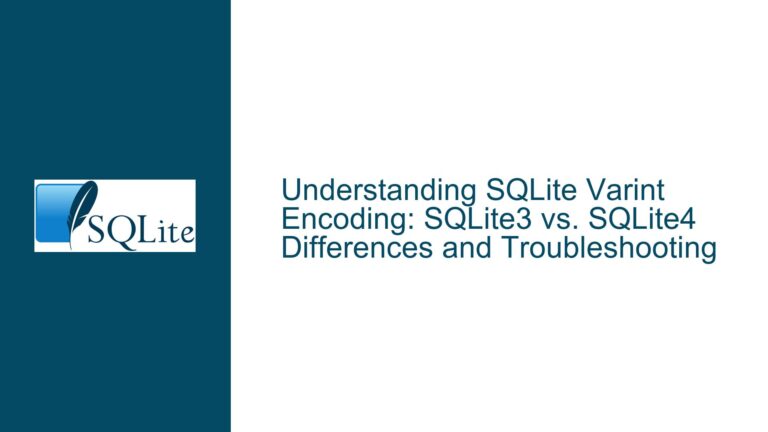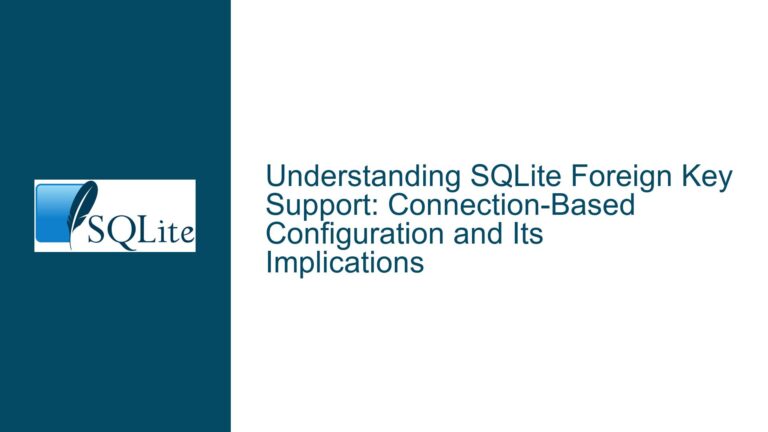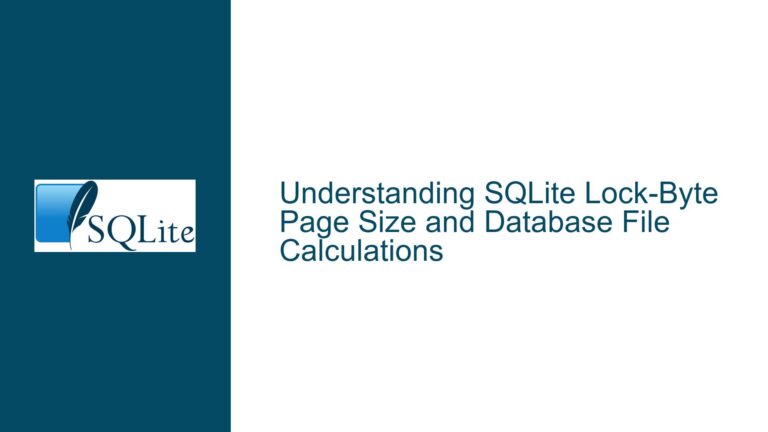Nanotime as Primary Key: Feasibility and Considerations
Nanotime as Primary Key: Understanding the Implications
The concept of using nanotime as a primary key in SQLite raises several important considerations, particularly around data integrity, sorting, and the limitations of SQLite’s integer type. Nanotime, which represents time at nanosecond precision, is often proposed as a unique identifier due to its high precision and the assumption that it will always be unique. However, the implementation of nanotime as a primary key in SQLite is not as straightforward as it might seem. This post will delve into the nuances of using nanotime as a primary key, the potential pitfalls, and the technical constraints that must be addressed to ensure a robust and reliable database schema.
Signed Integer Limitations and Sorting Issues
One of the primary challenges of using nanotime as a primary key in SQLite stems from the fact that SQLite integers are signed. This means that the range of values that can be stored in an integer column is from -9,223,372,036,854,775,808 to 9,223,372,036,854,775,807. When nanotime values are stored as integers, they must fit within this range. However, the nanotime specification often represents time as a 64-bit unsigned integer, which can lead to complications when these values are stored in a signed integer column.
The signed nature of SQLite integers introduces a critical issue with sorting. Specifically, years 2098-2225 would sort before years 1970-2097 due to the way signed integers are handled. This is because the highest bit in a signed integer is used to represent the sign (positive or negative), and when the nanotime values exceed the positive range of a signed 64-bit integer, they wrap around into negative values. This behavior can lead to unexpected and incorrect sorting of records, which is particularly problematic when the primary key is used for indexing and querying.
To illustrate this issue, consider a scenario where nanotime values are used to timestamp events. If the nanotime values exceed the positive range of a signed 64-bit integer, events that occur after the year 2098 could be sorted before events that occurred in the 1970s. This would render the primary key ineffective for maintaining chronological order, which is often a critical requirement for time-based data.
Troubleshooting Steps, Solutions & Fixes
To address the challenges of using nanotime as a primary key in SQLite, several strategies can be employed. These strategies involve modifying the way nanotime values are stored, adjusting the schema design, or using alternative approaches to achieve the desired functionality.
1. Adjusting Nanotime Values to Fit Within Signed Integer Range
One approach to mitigating the signed integer limitation is to adjust the nanotime values so that they fit within the range of a signed 64-bit integer. This can be achieved by subtracting a fixed offset from the nanotime values before storing them in the database. The offset should be chosen such that the adjusted values remain within the positive range of a signed 64-bit integer.
For example, if the nanotime values are expected to range from the year 1970 to the year 2225, an offset corresponding to the year 1970 could be subtracted from all nanotime values. This would ensure that the adjusted values remain positive and can be correctly sorted within the signed integer range. When retrieving the nanotime values, the offset can be added back to restore the original values.
However, this approach requires careful consideration of the expected range of nanotime values and the potential for overflow if the values exceed the adjusted range. Additionally, it introduces complexity in the application logic, as the offset must be consistently applied when inserting and retrieving data.
2. Using a Custom Data Type or Extension for Unsigned Integers
Another approach is to use a custom data type or extension that supports unsigned 64-bit integers. While SQLite does not natively support unsigned integers, it is possible to create a custom extension or use an existing one that provides this functionality. By using an unsigned integer data type, the full range of nanotime values can be stored without the risk of overflow or incorrect sorting.
Creating a custom extension involves writing C code that implements the desired data type and integrating it with SQLite. This approach requires a deep understanding of SQLite’s extension API and may not be feasible for all developers. Alternatively, existing extensions that provide unsigned integer support can be used, provided they are compatible with the specific requirements of the application.
3. Storing Nanotime as Text or Blob
If modifying the nanotime values or using a custom data type is not feasible, an alternative approach is to store the nanotime values as text or blob data. This allows the full range of nanotime values to be stored without the limitations of signed integers. However, storing nanotime as text or blob introduces its own set of challenges, particularly around sorting and indexing.
When nanotime values are stored as text, they must be formatted in a way that ensures correct sorting. This typically involves using a fixed-length format with leading zeros, such as ISO 8601 format with nanosecond precision. While this approach allows for correct sorting, it may result in larger storage requirements and slower performance compared to integer-based storage.
Storing nanotime values as blob data can also be considered, particularly if the values are used primarily for storage and retrieval rather than sorting or indexing. However, this approach may limit the ability to perform certain operations on the data, such as range queries or comparisons.
4. Using a Composite Primary Key
In some cases, it may be beneficial to use a composite primary key that includes both a nanotime value and another unique identifier. This approach can help mitigate the limitations of using nanotime as a standalone primary key while still leveraging its high precision for uniqueness.
For example, a composite primary key could consist of a nanotime value and a user ID or device ID. This would ensure that the primary key remains unique even if the nanotime values are not strictly monotonic or if there are collisions due to the limitations of signed integers. However, this approach requires careful design to ensure that the composite key meets the application’s requirements for uniqueness and sorting.
5. Evaluating the Need for Nanotime Precision
Finally, it is important to evaluate whether the nanosecond precision provided by nanotime is truly necessary for the application. In many cases, microsecond or millisecond precision may be sufficient, and using a lower precision can simplify the storage and handling of time-based data.
If lower precision is acceptable, the nanotime values can be truncated or rounded before being stored in the database. This reduces the range of values that need to be stored and can help avoid the issues associated with signed integers. Additionally, using a lower precision can improve performance and reduce storage requirements.
Conclusion
Using nanotime as a primary key in SQLite presents several challenges, particularly due to the signed nature of SQLite integers and the potential for incorrect sorting. However, with careful consideration and the appropriate strategies, it is possible to implement a robust and reliable solution that meets the application’s requirements. Whether through adjusting nanotime values, using custom data types, or exploring alternative storage formats, developers can overcome the limitations of SQLite and leverage the high precision of nanotime for unique identification and time-based data management.






